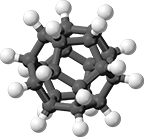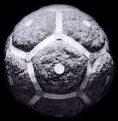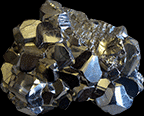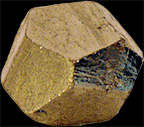PORCELAINia
Spheres of Pythagoras

 |
The Docecahedron “There is no polygon more intimately associated with the Golden Ratio than the pentagon. There is no ratio more intimately associated with life than the Golden Ratio. Is it any wonder that one who sculpts in porcelain would choose any shape other than the dodecahedron?" ~ Bobby Jaber |
 |
|
Astrophysicists recently discovered that it could be the shape of our Universe. Chemists have captured its pleasing symmetry in hydrocarbon compounds. Biologists envision it in the structure of the pariacoto virus. Yet we can also hold its natural crystallized form in our hand as fool’s gold. This beautiful, yet all too ubiquitous shape is the dodecahedron. Each of its 12 pentagonal faces hold the qualities of the golden ratio. And within its pure symmetry lies the key to the geometry of the sphere.
The dodecahedron as a recognized form can be traced to Neolithic times. Archeologists have found its pristine shape in carved stones over four thousand years old and in Roman bronze artifacts from the 2nd and 3rd century CE. In ancient Greece it was rediscovered by the Pythagoreans as a universal essence and was later deemed the fifth element, quintessence, by Plato in his cosmological treatise, Timaeus. The dodecahedron was returned to over and over again by mystics, scientists, artists, geometers and scholars in its long journey through humanity’s history.
|
|
Spheres of Pythagoras
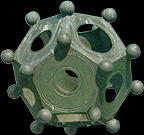 |
With the Spheres of Pythagoras series, Porcelainia celebrates the dodecahedron and offers tribute to Pythagoras, who elevated this form to an honored place as the “divine” symbol of the Universe. Pythagoras (569 - 475 BCE) was first to pay homage to the sphere and herald the symbolism of numbers as the language of the divine. The number five was particularly important to Pythagoras. From the “perfect fifth” of his musical canon, stoneworkers cast the perfect symmetry of classical architecture in marble. The divine properties of this chord are said to be “frozen” in to the golden ratio of the pentagon and the dodecahedron. This ratio links the “music of the spheres” or vibrations of the natural world to the most enduring creations of humankind. There was another kind of “Sphere of Pythagoras” in addition to his harmonic planetary spheres. These were the divinatory circles that healed through the power of numbers. Recent scholars have suggested that the 2000 year old mysterious Roman dodecahedra found in Scotland and in France could, in fact, be Pythagorean spheres. |
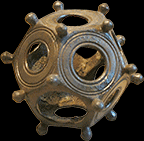 |
The world knows Pythagoras best as an eponym of one of the oldest and most famous rules of mathematics: the Pythagorean theorem – yet he was the founding Father of much more. Pythagoras embodied one of the finest crossroads between ancient knowledge and wisdom from the East to the West, and his teachings set the stage for the foundation of Western civilization. While Pythagoras’ significance to the history of science was often obscured by fear of mysticism, his legacy penetrated multiple disciplines, from philosophy to mathematics, music theory to architecture, politics, and oratory to the birth of our schools and Universities.
Each dodedecahedral porcelain piece in this series is named for a person intimately linked to Pythagoras and his deeper understanding of divine properties in the architecture of life.
Text by Bonnie DeVarco
AVERROES | ABU'L WAFA | BOETHIUS | IAMBLICHUS | THEANO | NICHOMACHUS
ZOROASTER | MOSES | PLATO | CICERO | SAPPHO | THEMISTOCLEA
